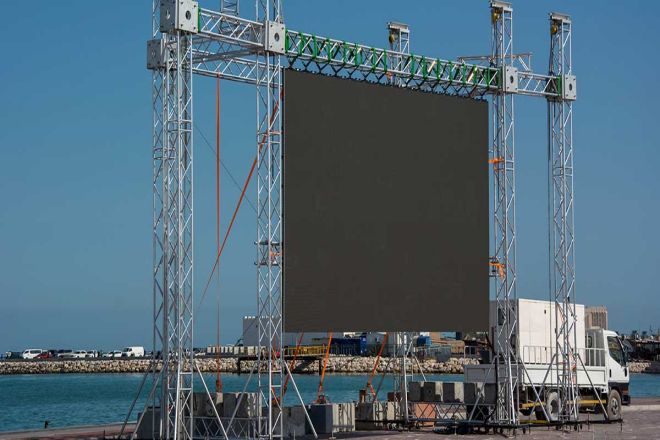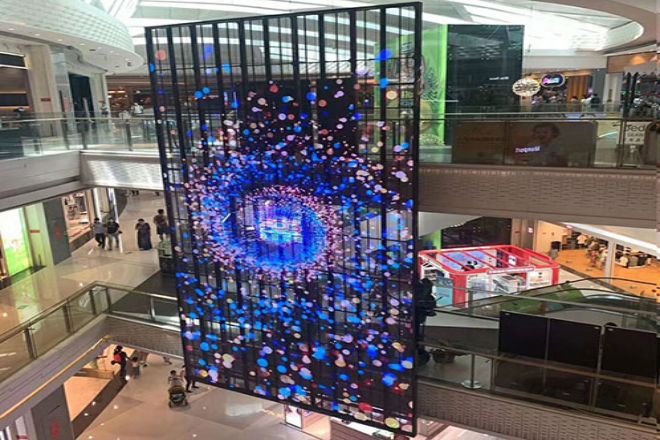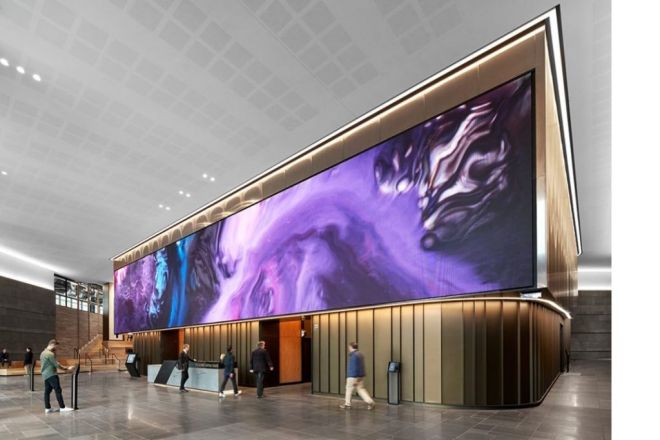Introduction

LED displays are widely used in many fields, and their performance and quality are constantly improving, providing vivid visual experiences for various scenes.
However, there are many factors to consider during the purchase process, such as resolution, size, brightness, refresh rate, etc., making the decision complicated. This article aims to discuss the 7 key points when purchasing LED displays to help you better understand product performance characteristics and make informed purchasing decisions.
1. Where is your LED display installed?

First, you need to determine where your LED display will be installed, indoors or outdoors. Ceiling or column? These are the types of LED displays that will affect your purchase.
1). Differences between different installation locations:
- Viewing effect:
Indoor installations usually pay more attention to the audience’s close viewing experience, so factors such as viewing angle, brightness, and color saturation need to be taken into consideration. Outdoor installations need to consider longer viewing distances and the impact of ambient light, so higher brightness and contrast are usually required.
- Environmental factors:
Outdoor installation needs to take into account environmental factors such as waterproofing, dustproof, sun protection, and lightning protection to ensure that the display screen can work normally under various harsh weather conditions. Indoor installation is relatively less affected by these factors.
- Installation difficulty and cost:
Different installation locations may require different installation materials and processes, so the installation difficulty and cost will also vary. For example, outdoor installations may require sturdier brackets and protection and, therefore, cost more.
2). For example:
2.1). Indoor installation:
Wall-mounted: suitable for spaces such as conference rooms, exhibition rooms, or store interiors. The display is hung directly on the wall, saving space and making it easy to view.
Ceiling type: Commonly found in large conference rooms, stadiums, or atriums of shopping malls. Through the hoisting method, the display screen can be suspended in the air, providing the audience with a larger viewing angle and a better viewing experience.
2.2). Outdoor installation:
Column type: Commonly found on outdoor billboards, squares, or public places. The display screen is installed on a special column, which can attract the audience’s attention from a long distance and is suitable for large-scale advertising or promotional activities.
Roof type: suitable for the roof of large buildings or commercial centers. Due to its higher location, it can cover a wider area and attract more viewers.
2. What do you plan to use the LED display for?
When considering purchasing an LED display, it is crucial to clarify your purpose and needs. This is because the purchase of LED displays involves not only a considerable investment but also its type, specifications, performance, etc., which vary depending on the usage scenario.
There are many types of LED displays, including LED displays specially designed for stage performances, LED displays used for commercial advertising displays, and LED displays suitable for indoor places such as conference rooms and lecture halls. Each LED display has its own unique characteristics and applicable scenarios, so we need to choose according to actual needs.
First of all, you need to think about where you want the LED display to play a role. Is it used for large-scale stage performances to bring shocking visual effects to the audience? Or is it used for commercial advertising to attract the attention of passers-by and enhance the brand image?
Or is it used in a conference room where team members can conduct presentations and share information? Clear usage scenarios help us choose the appropriate display type and specifications.
Secondly, you need to consider what value the LED display can bring to you. Do you hope to enhance your brand image and attract more potential customers through LED displays? Or do you want to use LED displays to improve meeting efficiency and promote communication among team members?
Or do you want to convey important information through LED displays to facilitate public access and understanding? Knowing where the value lies helps us better evaluate the display’s performance and effectiveness to ensure it meets our expectations and needs.
3. What is the LED screen size and resolution you want?

When choosing an LED display screen, screen size and resolution are two very critical parameters. The selection of these two parameters will directly affect the display effect and user experience.
First, let’s talk about screen size. Screen size mainly depends on where you plan to install this display and how far away the audience is from the display. For example, if you plan to use it in a large conference room or exhibition center, then you may need a larger screen to ensure that everyone can clearly see the content on the screen. Conversely, if installation space is limited or the audience is relatively close, a smaller screen may be more appropriate.
Secondly, let’s talk about resolution. Resolution is actually the number of pixels on the screen, which determines the clarity and detail of the image. The higher the resolution, the clearer the image and the richer the details.
If you plan to display text on the display or need to display detailed pictures and videos, then you need to choose a high-resolution display. Of course, high resolution also means higher costs, so you need to find a balance between budget and clarity.
In addition to screen size and resolution, other factors need to be considered when choosing an LED display, such as brightness, contrast, color reproduction, etc. These factors will also affect the final display effect.
Therefore, when choosing an LED display, you need to weigh the screen size and resolution based on your specific needs and usage scenarios. If you are not sure what parameters to choose, you can consult professional sales staff or technical personnel, who can provide more specific suggestions based on your needs.
4. Which group of people is the content of the LED display intended to target?
It is crucial to understand which group of people the content of the LED display is intended to target because this will directly affect the design, presentation, and effect of the display content. Specifically, there are several key reasons:
First, knowing your target audience can help you target your content more accurately. Different groups of people have different needs and interests. Only by deeply understanding their characteristics and preferences can we create display content that better meets their needs.
For example, content aimed at young people may be more fashionable and lively, while content aimed at business people may be more professional and practical.
Second, understanding your target audience can help optimize how your content is presented. Different groups of people receive information in different ways and have different preferences. Some people may prefer text descriptions, while others prefer pictures or videos.
Therefore, choosing an appropriate presentation method based on the characteristics of the target group can deliver information more effectively and improve the viewing experience.
Additionally, understanding your target audience can help improve your advertising effectiveness. If LED displays are mainly used for commercial advertising, then understanding the target population can help us place ads more accurately and increase the click-through rate and conversion rate of ads.
At the same time, advertising content targeted at specific groups of people is more likely to resonate with and interest them, thereby enhancing advertising effectiveness.
Finally, understanding your target audience can also help us better evaluate and optimize display performance. By observing and analyzing the viewing behavior and feedback of the target group, we can understand which content is more popular and which presentation methods are more effective so as to continuously optimize the content and form of the display and improve the overall effect.
5. Choice of viewing angle for LED display

First of all, the viewing angle determines the clarity and comfort of viewers viewing screen content in different positions. The viewing angle of the LED display includes two indicators, horizontal and vertical, which represent the range within which users can clearly observe all content on the screen from different directions.
If the viewing angle is too small, when viewers deviate from a certain angle directly in front of the screen, they may encounter problems such as blurred images, color distortion, or reduced contrast, thus affecting the viewing experience. Therefore, choosing an LED display with a large enough viewing angle can ensure that viewers can have a clear and comfortable visual experience in a wider range of positions.
Secondly, the viewing angle is also closely related to performance parameters such as brightness and contrast of the display screen. In some specific scenarios, such as outdoor advertising screens, the impact of direct sunlight and other factors on-screen brightness needs to be considered.
If the viewing angle is too large, the brightness of the screen may be dispersed and the display effect reduced. Therefore, when choosing an LED display, you need to weigh the viewing angle and other performance parameters according to the actual application scenario to achieve the best display effect.
6. LED display price and cost performance
The price and cost-effectiveness of LED displays vary depending on a variety of factors, including size, resolution, brightness, color performance, technical specifications, brand and quality, etc.
Generally speaking, the price of LED displays with larger sizes, high resolution, high brightness, and excellent color performance will be relatively high. At the same time, well-known brands and high-quality products often come with a hefty price tag.
Cost-effectiveness is a relative concept that involves the balance between product performance and price. When choosing an LED display, you must not only consider the price but also comprehensively evaluate whether its performance meets your needs and whether it can bring a good experience during use.
When evaluating the price/performance ratio, it is recommended that consumers or purchasers first clarify their purpose of use and needs and then compare product performance, price, and after-sales service of different brands and models.
You can learn about the performance of the product by consulting product information, consulting professionals, or referring to reviews from other users. At the same time, we should also pay attention to the after-sales service policy of the product to ensure that we can receive timely technical support and maintenance services during use.
7. What is the after-sales service of LED display screens?

First of all, after-sales service is the key to ensuring product quality and extending product service life. As a high-tech product, the stability and reliability of LED display screens directly affect the use effect.
High-quality after-sales service can ensure that when a display fails or has a problem; it can receive timely and professional repairs and solutions to avoid losses and impacts caused by the failure.
Secondly, after-sales service is an important part of improving user experience. After purchasing an LED display, users may encounter various problems or confusion during use.
A complete after-sales service system can provide timely technical support, operating guidance, and maintenance suggestions to help users better use the display and improve user experience and satisfaction.
In addition, after-sales service is also an important criterion for measuring the strength of a brand or enterprise. A brand or company with high-quality after-sales service usually has a strong technical team, a complete service network, and a good customer service concept. Such brands or companies are more trustworthy and can provide users with more reliable and stable LED display products and services.
Finally, considering the complex installation and debugging processes that LED displays may involve, high-quality after-sales service can provide the necessary help and support during the installation and debugging stages to ensure that the display can be put into use smoothly.
Conclusion
The above is all the content of this article. Have you understood it clearly? If you still want to know more about LED displays, please get in touch with us.
